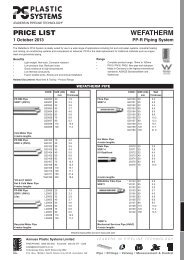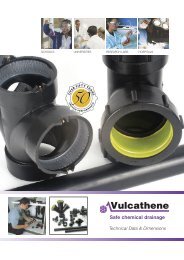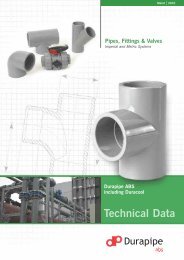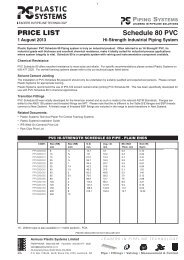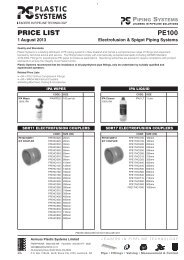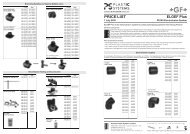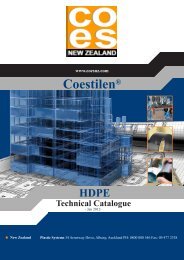Beta (b)-PP from Georg Fischer A synonym for ... - Plastic Systems
Beta (b)-PP from Georg Fischer A synonym for ... - Plastic Systems
Beta (b)-PP from Georg Fischer A synonym for ... - Plastic Systems
You also want an ePaper? Increase the reach of your titles
YUMPU automatically turns print PDFs into web optimized ePapers that Google loves.
Chemical resistance<br />
For industrial piping systems, in addition to the creep<br />
strength and the impact resistance, the chemical resistance<br />
of the piping material is of major importance.<br />
The preferred point of chemical attack or diffusion /<br />
swelling of <strong>PP</strong> pipes which come into contact with<br />
media is the amorphous, i.e. randomly arranged area<br />
between the crystallites of a semi crystalline material.<br />
Because of the special nucleation of <strong>Beta</strong>-<strong>PP</strong>-H and a<br />
processing technique which is adapted optimally to the<br />
material, the best possible crystallinity, in other words<br />
a reduction of the amorphous section, as well as a<br />
very fine crystalline structure is achieved (see Fig. 1).<br />
In this way and in combination with the very good<br />
quality of the inner surfaces, the penetration of chemicals<br />
or an attack on the surface can be dramatically<br />
reduced. An exceptionally efficient heat stabiliser<br />
system also creates a long-lasting buffer against<br />
thermo-oxidative degradation. For the colour, a highquality<br />
titanium dioxide (TiO2) is used as a chemically<br />
inert pigment. Extensive long-term practical tests,<br />
long-term pressure tests under chemical exposure or<br />
simple immersion tests have confirmed the superior<br />
chemical resistance of <strong>Beta</strong>-<strong>PP</strong>-H pipes <strong>from</strong> <strong>Georg</strong><br />
<strong>Fischer</strong> which come into contact with the many relevant<br />
media classes in practice. <strong>Beta</strong>-<strong>PP</strong>-H meets with<br />
a large safety margin the requirements of the current<br />
draft of the DIBt mould compound listing <strong>for</strong> <strong>PP</strong> also in<br />
relation to the FNCT test.<br />
<strong>Georg</strong> <strong>Fischer</strong> offers the chemical industry a solution<br />
ideally suited to their specific requirements in<br />
terms of chemical resistance of <strong>PP</strong> in the <strong>for</strong>m of<br />
<strong>Beta</strong>-<strong>PP</strong>-H.<br />
For detailed in<strong>for</strong>mation, please check the comprehensive<br />
list of chemical resistances <strong>from</strong> <strong>Georg</strong><br />
<strong>Fischer</strong> or contact your <strong>Georg</strong> <strong>Fischer</strong> subsidiary.<br />
The good chemical resistance of <strong>Beta</strong>-<strong>PP</strong>-H is especially<br />
evident in contact with oxidative media; Fig. 8<br />
shows a section of a <strong>PP</strong> pipe used to convey a 30%<br />
hydrogen peroxide solution (T=20-30°C; p



